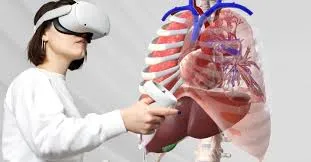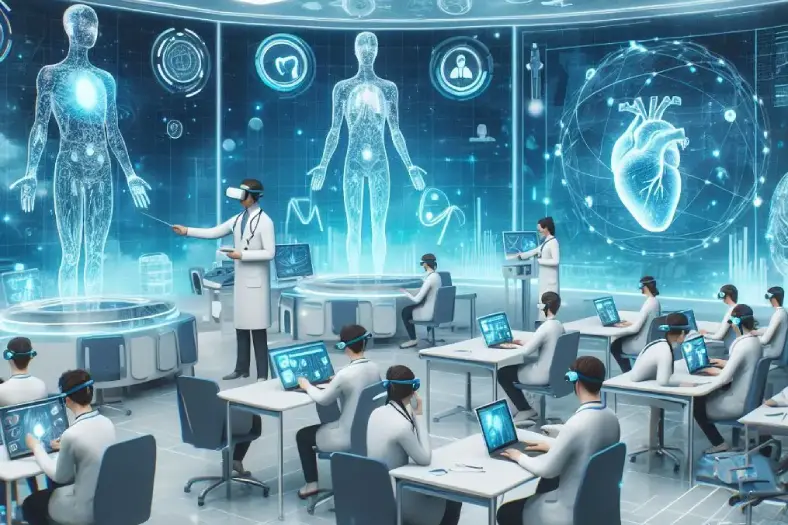Imagine a future where the journey to becoming a healthcare professional is not marked by years of costly, traditional classroom education that is static and one size fits all, but is instead a continuous, self-directed voyage empowered by cutting-edge technologies. This is not a distant dream but an impending reality as we stand on the brink of a transformative shift in medical education. Welcome to the era of Education as a Service (EaaS), where aspiring doctors learn at their own pace, fueled by AI-powered personalization, immersive XR experiences, and a continuous learning model that empowers them throughout their careers. This, my friends, is not science fiction, but the inevitable future of medical education that is both economically viable and universally accessible.
Breaking Free from the Traditional Mold
Traditionally, medical education has been product-based, confined within the walls of institutions, and structured around a rigid timeline that spans several years. Students attend lectures, memorize vast amounts of information, and prepare for high-stakes exams. This model, while foundational, is prohibitively expensive, leaving many talented individuals with crushing debt and limited access. It’s rigid and inflexible, failing to adapt to the ever-evolving landscape of medicine. And let’s face it, it can be downright boring, relying on outdated methods that fail to engage today’s tech-savvy students. The demand for a more flexible, inclusive, and efficient approach to medical training has never been more pressing, and EaaS offers a revolutionary solution.
EaaS in Medical Education
Education as a Service (EaaS) represents a seismic shift from the conventional product-based approach to a service-oriented model. EaaS leverages AI, XR (including Virtual Reality and Augmented Reality), and other digital technologies to offer personalized, adaptive, and immersive learning experiences that cater to the individual needs of each learner. This model supports a self-directed and continuous approach to medical education, allowing learners to acquire and update their skills in real-time, in response to the evolving demands of healthcare.
The Role of AI and XR in Shaping EaaS
AI and XR technologies are at the heart of this educational revolution, offering unprecedented opportunities for simulation, personalization, and engagement. AI-driven platforms can tailor learning experiences to the individual’s pace, style, and proficiency level, identifying weaknesses and adapting content accordingly. Meanwhile, XR technologies provide immersive simulations of medical procedures and environments, offering hands-on experience without the geographical or logistical constraints of traditional clinical training.

Imagine an AI tutor that analyzes your strengths, weaknesses, and learning style, tailoring educational content to your unique needs. No more one-size-fits-all lectures! Instead, you’ll receive personalized learning modules, adaptive quizzes, and virtual simulations that maximize your understanding and retention.
Imagine stepping into a virtual operating room, practicing a complex procedure on a holographic patient, or interacting with patients from diverse backgrounds in simulated clinical scenarios. XR technologies like AR and VR will transform medical education from theory to experiential learning, fostering deeper understanding and improving clinical skills.
The EaaS approach doesn’t end with graduation. It’s a lifelong learning platform that provides on-demand access to updated knowledge, skill-building resources, and peer-to-peer learning communities. Imagine a future where doctors can access the latest research findings, hone their skills with interactive simulations, and connect with colleagues from around the world – all within a single, accessible platform.
These technologies not only enhance the learning experience but also significantly reduce the cost and barriers to accessing medical education. By moving away from the high overheads associated with traditional medical schools (including physical infrastructure and equipment), EaaS can democratize medical education, making it more affordable and accessible to a global audience. But it’s not just about technology. The EaaS model also demands a shift in the economic paradigm
Economic Implications and Accessibility
The economic model underpinning EaaS in medical education reflects a shift towards more cost-effective and scalable solutions. Instead of charging exorbitant upfront fees, EaaS could offer subscription-based models, micro-credentialing, and pay-as-you-learn schemes. This will provide flexibility and affordability, opening up medical education to a wider and more diverse pool of learners. This approach not only alleviates the financial burden on students but also addresses the global shortage of healthcare professionals by increasing access to everyone, regardless of their socioeconomic background.
The Path Forward
As we look to the future, the transition to EaaS in medical education requires a collaborative effort among educational institutions, technology companies, healthcare organizations, and policymakers. Developing standards, ensuring quality, and addressing accreditation are critical steps in realizing the full potential of this model. Moreover, fostering a culture that values continuous learning and adaptability among healthcare professionals is essential for the success of EaaS. But the potential benefits are undeniable: increased access to quality education, improved learning outcomes, and a more prepared and adaptable medical workforce.
Conclusion
The future of medical education through EaaS presents a vision of a more adaptable, inclusive, and efficient framework for training healthcare professionals. By harnessing the power of AI and XR, we can transcend the limitations of traditional education, offering a pathway that is not only economically viable but also capable of producing a workforce that is equipped to meet the challenges of modern healthcare. As we embrace this shift, we pave the way for a healthier future, powered by innovation and accessibility.
So, the question isn’t whether EaaS will happen, but when. Are you ready to embrace this exciting future and rewrite the script for medical education? Let’s start the conversation and ensure that everyone, everywhere, has the opportunity to become a skilled and compassionate healthcare professional.
Join me in exploring this exciting frontier, where the journey of learning never ends, and the possibilities for improving healthcare are limitless. Together, let’s shape a future where medical education is a service that adapts, grows, and revolutionizes the very essence of healthcare training.



0 Comments